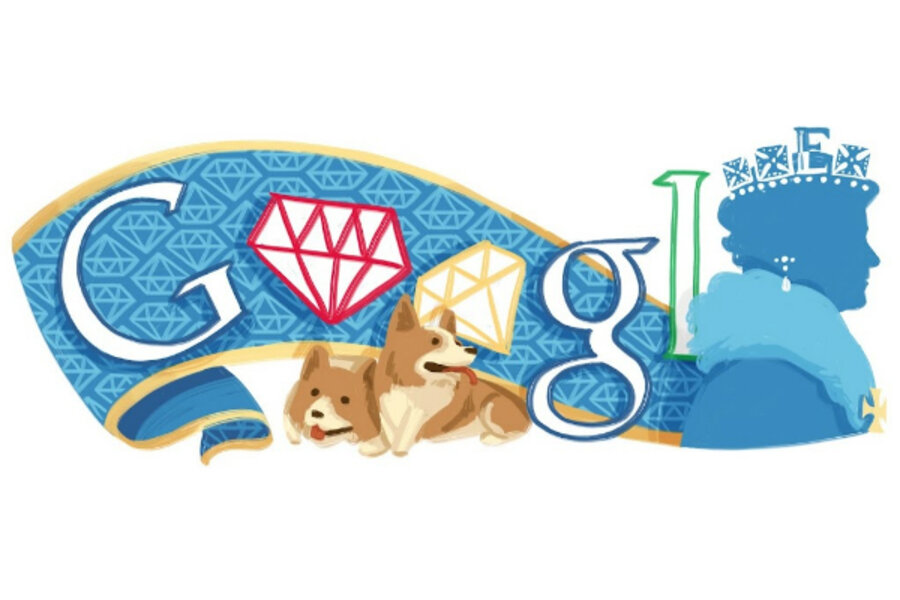For Queen Elizabeth, a Google doodle of diamonds and doggies
Loading...
| London
Queen Elizabeth graces the front page of Google today in the UK in a doodle marking her diamond jubilee, offering the rest of the world but a glimpse of the playful pop art and consumer kitsch on display here in Britain.
Scots guardsmen cupcake toppers, union jacks on toothpicks, ice queen scoops. Bunting: enough to string together the old empire. Royal photos on thimbles, spoons, tea cups, shot glasses, egg cups, tea towels – the usual tat, as the Brits say. Jubilee thongs? Yes.
Then there’s the cleverness contest surrounding the WWII-era slogan, “Keep Calm and Carry On.” Written on a women's compact: “Keep Calm and Powder On.”
Comparatively, Google’s doodle is an understated affair. The letter O’s are diamonds, symbolic of the 60th (diamond) anniversary on the throne. The E sits as a jewel in the queen’s crown. The queen appears in two-dimensional contour; her beloved corgis, however, look ready to leap off the page.
The playful riffs on royal themes reflect the generally favorable mood toward the royals of late.
A YouGov poll last month found 67 percent agreeing the monarchy is good for Britain, and 86 percent approve of Queen Elizabeth. This is up from the days when her children's divorces dominated the headlines and her slowness to show emotion over the death of Princess Diana frustrated many.
Still, the public mood is not really one of royal reverence. Britons are in party mode at the start of a long weekend – Monday and Tuesday being holidays as part of the four-day official jubilee celebration. Many Londoners took the chance to flee on summer vacations, as foreign and British tourists crowd into the city for events that include Sunday’s royal family flotilla on the Thames and Tuesday’s carriage procession.
Among the street art for the crowds will be the construction Sunday of a 94-sq.-ft. portrait of Queen Elizabeth made from 3,120 squares of cake – one for each week of her reign.
German-born baker Gerhard Jenne came up with the idea. Mr. Jenne dipped each piece of lemon cake into one of 24 frosting colors, turning each into a pixel of this icing illustration.
Jenne’s a fan of the queen, but not so much so that he feels the need to become her subject even 30 years after moving to London. He doesn’t expect to meet her on Sunday, when he publicly arranges the cake squares into the portrait.
“It’s very interesting how the queen has changed. Even from 30 years ago, [the royals] are much closer to the people now,” he says. “You almost feel like she might come see you…. There could just be a 1 in 40 million chance.”
After spending hundreds of hours on the cake, he expects it to be gobbled up within 20 minutes when it’s opened up to the crowds.
Some customers in his Konditor & Cook bakeries have asked him if it’s proper for an image of Her Highness to be eaten.
“I just said yes, it’s fine by me. At the end of the day, it’s a cake, it’s a bit of fun. And she seems like a humorous person.”
An earlier version of this story incorrectly attributed the phrase "Keep calm and carry on" to the British royal family.





